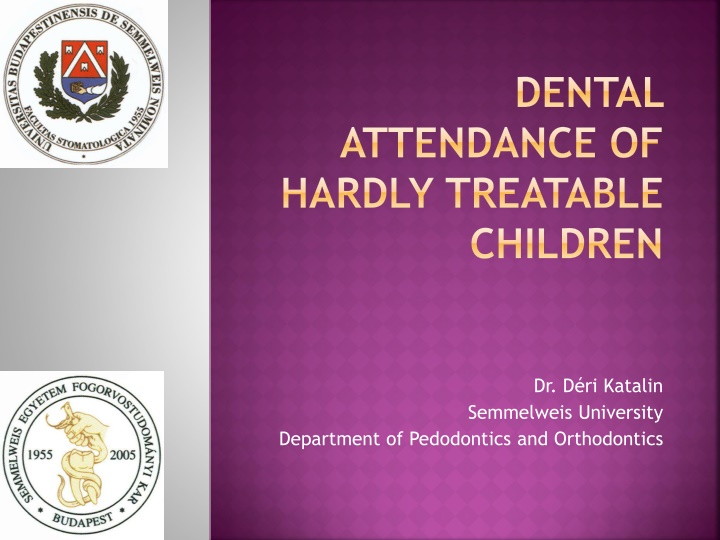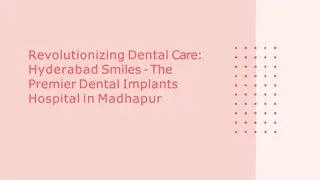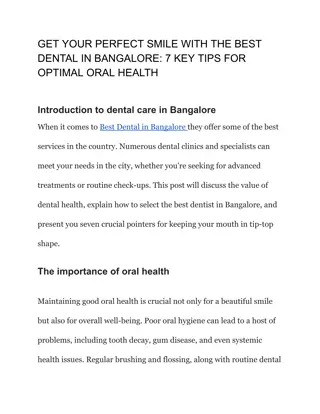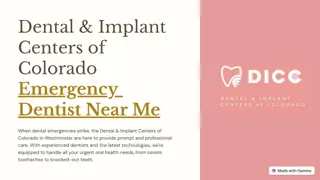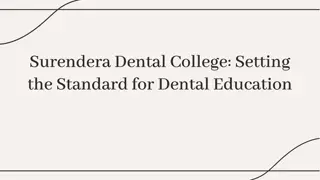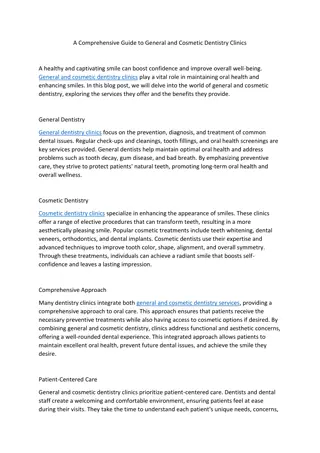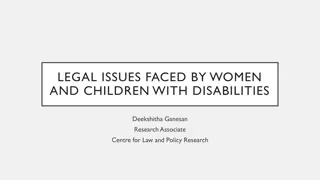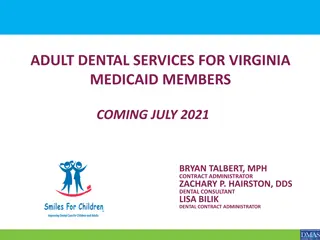Dental Treatment Strategies for Children with Disabilities
This presentation covers the challenges and treatment possibilities for children with disabilities in dental attendance. It discusses the etiology of fear and anxiety related to dentistry, along with the various causes such as anxiety and mental or physical disabilities. Treatment options are explored based on the level of disability, including tips for handling fear and anxiety, managing mild mental disabilities, and accommodating physical disabilities. Sedation techniques and their different levels are also outlined, emphasizing the importance of parental consent. Overall, the content provides valuable insights into making dental visits more comfortable and effective for children with disabilities.
Download Presentation

Please find below an Image/Link to download the presentation.
The content on the website is provided AS IS for your information and personal use only. It may not be sold, licensed, or shared on other websites without obtaining consent from the author.If you encounter any issues during the download, it is possible that the publisher has removed the file from their server.
You are allowed to download the files provided on this website for personal or commercial use, subject to the condition that they are used lawfully. All files are the property of their respective owners.
The content on the website is provided AS IS for your information and personal use only. It may not be sold, licensed, or shared on other websites without obtaining consent from the author.
E N D
Presentation Transcript
DENTAL ATTENDANCE OF HARDLY TREATABLE CHILDREN Dr. D ri Katalin Semmelweis University Department of Pedodontics and Orthodontics
INTRODUCTION Dentistry Fear Pain Pain subjective 1,5-2 years old low pain threshold 11-12 years old- pain-pressure-discomfort Pain relief Local anaesthesia Sedation General anaesthesia
ETIOLOGY Causes: Anxiety: no definite reason Fear : concrete reason Subjective Objective
ETIOLOGY Disability: Mental: mild: IQ 50-7o medium: IQ < 50 severe : IQ < 30 Phisical (damage of central nervous system) Organic (cardiovascular disease, diabetes, renal disease) Senses (blindness, deafness)
TREATMENT POSSIBILITIES Fear/Anxiety: Not tired Not too long appointments get together/introduction before any treatment Tell, Show, Do Familiar/nice enviroment- waiting room/dental office No long waiting Praise, reward Involve the child in the treatment
TREATMENT POSSIBILITIES Mild mental disability: Extraordinary patience, understanding i.e.: Down sy.-kind, good cooperation Extraordinary speed Simpliest but effective treatment Presence of parent Prevention !!!
TREATMENT POSSIBILITIES Phisical disability Wheelchair, problems with movement coordination Access the dental unit Extra assistance needed suction, rinse Disability of senses Blindness : touch Deafness : mouth reading (mask) , slow speech
SEDATION Consciousness power off on different levels Superficial: Maintain automatic reflexes Conscious/aware Able to response Deep: Not maintained automatic reflexes !!!!: Consent form signed by the parents!!!
SEDATION Oral Intramuscular Intravenous Rectal Inhalation
ORAL SEDATION Benzodiazepins: Diazepam, midazolam Advantage : Preparation at home (responsible parent) Cheap Disadvantage: Absorption - uncertain Paradox reaction Adequate timing, adequate dosage: Diazepam: 0,2-0,5 mg/kg Prolonged effect Midazolam: 0,3-0,5 mg/kg 7,5/15 mg pill or venous inj. sol. swallowed Effective in 30 mins , lasts for 1-2 hours Nasal drops effect in 10 mins
SEDATION Intramuscular Faster absorption More cooperation needed Painful If needle veneflon is better Intravenous Directly to the blood stream No absorption problems Lower dose More cooperation (veneflon) Rectal Scandinavian countries - diazepam solution
CONSCIOUS SEDATION N2O /dinitrogen-oxid/ nitrous oxide Discovered: 1793 Joseph Priestley (O2) Name : laughing gas 1799 Sir Humphrey Davy For 40 years: primary use of N2O was for recreational enjoyment and public shows First clinical use : 1840s: Horace Wells, american dentist, tooth extraction for himself First clinical use in Hungary: 1847 J nos Balassa
EFFECTS OF N2O Analgesic Anxiolytic, sedative Anaesthetic
CHARACTERISTICS OF N2O Good analgetic Mild anaesthetic Low solubility in blood Elimination without metabolism Direct cardiodepressive Methionin synthetase-, folic acid metabolism- and DNA synthesis inhibitor
CHARACTERISTICS OF N2O It can cause: Diffuse hypoxia Agranulocytosis, bone marrow depression , myeloneuropathy Teratogenic
USE IN DENTISTRY 2 types of methods: 1.) O2 and N2O dosage separately 2.) O2 and N2O fix 50/50 gas mixture Indication: Anxiolysis or sedation Mild or medium strength pain killer
1.) METHOD :O2 N2O CONTROLLABLE DOSAGES 100 % O2 inhalation for 2-3 minutes Slow raise of N2O concentration 5-25 %- mild sedation and analgesia Mild numbness in hands and legs 30 % - explicit analgesia- euphoria 35 % < side effects more often Sweating, restlessness, vomiting, panic, nightmare Finishing : 100 % O2 inhalation for 5 minutes Leaving -20 minutes Presence of anaesthesiologist is required!!
2.) METHOD SET DOSAGE N2O O2 fix 50-50 % gas mixture Specialized dentist is enough no anaesthesiologist required (in certain countries) No chance of diffuse hypoxia O2 saturation does not decrease during inhalation but increases No need for systemic reoxygenation after inhalation
INDICATIONS Children older than 3 years Adults with anxiety or phobia Patients with mild mental disability
CONTRAINDICATIONS Children under 3 years Pregnancy ASA III.: severe systemic disease ASA IV.: severe systemic disease that is a constant threat to life Intracranial hypertension Bullosus emphysema Pneumothorax
CONTRAINDICATIONS Abdominal distension After certain eye surgery Use of ophthalmological gases (SF6, C3F8,C2F6) Total lack of patient cooperation
DOSAGE- 2.) METHOD Nose-mouth mask Natural breathing movements define the amount of gas inhaled. Suggested flow speed: Children : 3-9 l/min Adult : 6-12 l/min
APPLICATION- 2.) METHOD Verbal communication with the patient during inhalation If no verbal feedback -> suspension! Effect : 3 minutes after inhalation Average application time: 30 minutes Maximal: 60 minutes Repeated use : max 15 days
PATIENT MONITORING -2.) M. Evaluation of clinical condition Properly relaxed Normal breathing Patient can follow simple instructions If sedation is too deep : no verbal feedback/contact-> suspension!! After treatment: Remove the mask 5 minutes relaxing in the dental chair
TERMS OF USE Proper ventillation in the operation room N2O cc. of air should stay below 25 ppm! Proper storage of gas mixture Above zero celsius Fix vertical position of the product
POSSIBLE SIDE EFFECTS Neurological Infrequent (1-10/1000) excitement euphoria headache vertigo Anxiety mood disorders
POSSIBLE SIDE EFFECTS Gastrointestinal Infrequent (1-10/1000) Nausea Rare (1-10/10000) i.e.: abdominal distension
DRUG INTERACTIONS Potentiates certain CNS drugs i.e opiates, benzodiazepines
HYPNOSIS Conscious modification Undesired activities cannot be forced Fear control Requires hypnotherapist
GENERAL ANAESTHESIA Indication: Severe mental/phisical disability Severe psychiatric disorders Under the age of 3
GENERAL ANAESTHESIA Contraindications: Severe renal/cardiovascular/respiratorical/neurological diseases Not controlled Anaemia/hypothyreosis/diabetes/adrenocortical insuff. Cervical spinal disorders
GENERAL ANAESTHESIA Premedication: Atropin (parasympatholyticum) 0,2 mg/kg Salivation decreases Respiratory secreation decreases Eliminate vagus reflex Disadvantages: tachycardia, dry mucose /not used/ Sedative : diazepam (Seduxen) or midazolam (Dormicum) 0,3-0,5 mg /kg Relaxation Potentiates the narcotics Amnesia prevent postnarcotic consequences prevent convulsion/spasm Suspension: anexate
GENERAL ANAESTHESIA Narcotics: Propofol: initial : easy sleep, fast and clear awakening maintained : prolonged awakening No vomit Breathing depression Easy controlled depth of narcosis Lower postoperative side effects Iv. 2-3 mg/kg initially, 6-10 mg/kg/hour maintained Inhalation anaesthetics: Sevoflurane (initial/maintained) Isoflurane (maintained) Desflurane (maintained)
GENERAL ANAESTHESIA Narcotics (earlier) Calypsol: Intravenous/intramuscular Often : agitation, nightmares Recently: propofol Other medication: Pain killers: During surgery: opiates (fentanyl, nalbuphin(Nubain) ) After surgery: non-steroids :algopyrin, ibuprophen, diclofenac, paracetamol
PERSONAL TERMS OF G.A. Educated anaesthesiologist and nurses Educated pediatric dentist and assistant Capable patient: No acute respiratory or contagious disease In proper cardiorespiratorical condition Blood test CBC (Complete Blood Count) PTT (Partial Thromboplastine Time) QT / INR / prothrombine time Detailed individual and family anamnesis about haemophilia Current medication ? (syncumar, aspirin, clopidogrel, LMWH )
OTHER TERMS OF G.A. Operation room Anaesthetic machine Pulzoximeter, capnograph
OTHER TERMS OF G.A. Blood pressure , EKG Dental equipment, exhaustor Instruments and medication for resuscitation
INSTRUCTIONS To the parents: No breakfast Last drink (1-1,5 dl water/tea) at 7 a.m. Take usual morning medication After narcosis: If totally conscious and no vomit: First drink 1 hour First eat 2 hours Terms of leaving the hospital: Full conscious, good strength, after drinking, eating, and urinate, accompanying person present, can be delivered back to the hospital
CONSENT FORM Parents have to read and sign it with responsibility Status taking , treatment PLAN in advance Aim : eliminate all possible causes of problems for long term Treatment plan is only estimated Changes might occur during surgery Preliminary permission for tooth extractions needed
DENTAL TREATMENTS Scaling, polishing Primary tooth filling, grinding Primary tooth extraction Permanent tooth Filling Extraction Root canal treatment Minor surgeries i.e.: mucocele, supernumerary tooth, wisdom tooth
PROBLEMS WITH TREATMENT AND PLANNING Examination without sedation - limited Quite poor oral hygiene no hope for improvement Problem solving + prevention Severe accompanying diseases no mastication no use of teeth Problem solving (long term without pain and inflammation versus conservative treatment) Basic disease relative contraindication for g.a. measure cost- benefit ratio
PROBLEMS WITH TREATMENT AND PLANNING Reasonable order of treatments Calculus, plaque, inflamed, bleedeng gingiva 1x filling 2x scaling, pol. 3x extractions Filling No precise occlusal control Low dimensions/underfilled Root canal treatment Unsecure success Anterior teeth (esthetics) In one session No x-ray control (yet)
PROBLEMS WITH TREATMENT AND PLANNING Real indication for g.a.?? Careful deliberation i.e.: destroyed milk molars but no sign of inflammation under the age of 8 extraction would be considered early no mastication for years so called rct too unsecure no indication for g.a. in case of inlammation recall trepanation or g.a.and extraction Extreme amount of plaque and calculus + no other pb + no hope for improving oral hygiene no indication for g.a.(cost/benefit)
PROBLEMS WITH TREATMENT AND PLANNING Destroyed molar, caries profunda, pulp is very close extraction Indirect/direct pulpcapping not suggested Unsecure success Postoperative complaint might be impossible to follow (no clear feed back) High speed!!! Experianced dentist, assistant Etching+bonding 2in1, high speed polym. lamp Optimal time of narcosis : max. 2 hours Aim : everything in one session!
PROBLEMS WITH TREATMENT AND PLANNING Not able to follow postop. instructions Extraction suture (resorbable) Inflammation +antibiotics No local anaesthetics Postop. mucose injuries Prosthetics Real indication? / real need? Functional need? (mastication?) Esthetics ? Is it a real issue? Practically possible? (more sessions, impression, occlusion control)
FOLLOW-UP In case of complaint - immediately No complaint 6 months No absolute contraindication of repeated g.a. BUT regarding the general risks of g.a. repetition is suggested as rare as possible Aspiration asphyxia, pneumonia Bronchospasm/ laryngospasm asphyxia Nerve injury (laying) paralysis
CASE REPORT 11, 21 caries penetrans rct apex locator Preparation cleaning , drying
CASE REPORT Fluid guttapercha technique (fluid gp + gp point) No lateral condensation Fast Set in 30 mins Temporary filling for 30 mins, meanwhile other treatments: 63, 65 radix extraction suture
CASE REPORT 36, 35 composite filling , GIC liner
CASE REPORT 53, 55, 46 radix extraction 11, 21 remove temp. filling, GIC base, Composite filling
